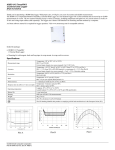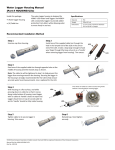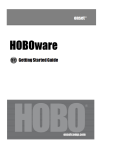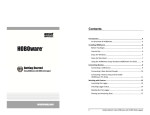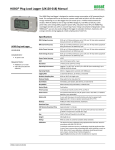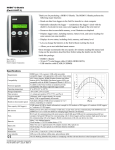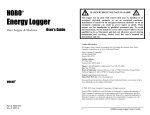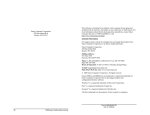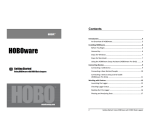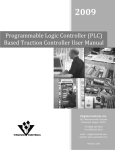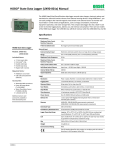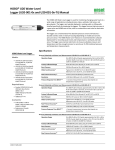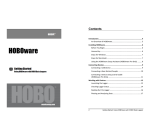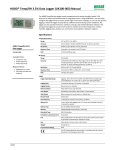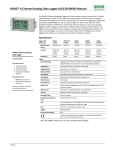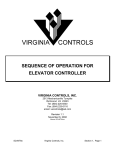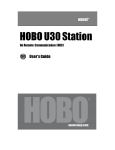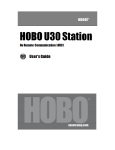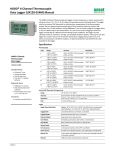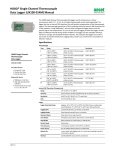Download HOBO U-Shuttle (U-DT
Transcript
HOBO® U-Shuttle (U-DT-x) Manual The U-DT-1 is compatible with all U-Series loggers (except the HOBO U30 Station), all UX-Series loggers, HOBO Weather Stations and Micro Stations (H21), and the HOBO Energy Logger (H22). The U-DT-2 is compatible with the HOBO U30 Station, HOBO Weather Stations and Micro Stations (H21), and HOBO Energy Logger (H22). The HOBO U-Shuttle performs the following major functions: • Reads out data from loggers in the field for transfer to a host computer • Optionally relaunches the logger—synchronizes the logger’s clock with the shuttle’s clock and (in most cases) sets logging to begin at the next interval • Preserves data in nonvolatile memory, even if batteries are depleted • Displays logger status, including memory, battery level, and sensor readings for some sensors (on some models) • Displays its own status, including clock, memory, and battery level • Lets you change the batteries in the field without resetting the clock • Allows you to test individual smart sensors (does not support the TRMSA-D) Specifications HOBO U-Shuttle Models: U-DT-1 U-DT-2 Compatibility U-DT-1: All U-Series loggers, all UX-Series loggers, HOBO Weather Stations and Micro Stations (H21), and HOBO Energy Logger (H22) U-DT-2: HOBO U30 Station, HOBO Weather Stations and Micro Stations (H21), and HOBO Energy Logger (H22) Firmware Upgrades Available on the Onset website as needed to provide compatibility with future supported logger models Operating Temperature 0° to 50°C (32° to 122°F) Storage Temperature -10° to 50°C (14° to 122°F) Time Accuracy ±1 minute per month at 25°C (77°F); see Plot A Logger-to-Shuttle Transfer Speed USB/optic: 64K in approximately 30 seconds Serial: 512K in approximately 60 seconds Shuttle-to-Host-Transfer Speed Full shuttle offload (4 MB) to host computer in 3 to 5 minutes, depending on computer Data Capacity (Full Loggers) 4 MB (minus 64 KB for shuttle information): enough for 504 readouts of 8K loggers, 63 readouts of 64K loggers, or 7 readouts of 512K loggers Idle Timeout Shuttle powers down after two minutes of idle time, except when actively communicating with HOBOware (see HOBOware User’s Guide for details) or changing logger batteries (10 minutes) Ports RJ-12 jack for communicating with smart sensors; mini-B full speed USB port for communicating with host computer; full speed USB port for communicating with U-Series loggers and base stations; high speed serial port for communicating with serial loggers. Shuttle communicates with only one device at a time. Batteries Main: 2 AA alkaline batteries / Clock backup: 1 CR1225 lithium battery (3 V) Battery Life Main: 2 AA alkaline batteries / Clock backup: 1 CR1225 lithium battery (3 V) Weight 153 g (5.4 oz) Dimensions 11.0 x 6.9 x 2.7 cm (4.35 x 2.70 x 1.05 inches) Case Materials ABS case with urethane rubber grips, polycarbonate label Included Items: • 30 cm (12 inch) serial logger cable • USB cable Required Items: • HOBOware 2.2 or later for U-DT-1 • HOBOware 2.6 or later for U-DT-2 • Compatible logger with appropriate cable and/or base station The CE Marking identifies this product as complying with all relevant directives in the European Union (EU). To maintain CE compliance, this product must be used with the supplied USB cable or equivalent (less than 3 m long). 13401-F MAN-UDTx HOBO U-Shuttle (U-DT-x) Manual Specifications (continued) Control Buttons The U-Shuttle has three dual-function buttons, labeled esc (on/off), yes (next), and no (alt). When the shuttle asks a question, press the yes or no button to answer the question. If the shuttle displays something other than a question, press the next button to advance to the next screen, or the alt button to view an alternative screen (if available). Press the esc (on/off) button to return to the main menu (Find Device/Shuttle Info). Press the esc (on/off) button again to power the shuttle off. Before Using the Shuttle for the First Time Plot A 1. Make sure the host computer’s clock and time zone are correct. If they are not, correct them before starting HOBOware. This information will be loaded into the shuttle, and will be the basis for all logger relaunches in the field. Onset strongly recommends that you spend a few minutes reading this manual and trying out the procedures described here before taking the shuttle into the field. Important note when using the HOBO U-Shuttle (U-DT-1) with a HOBO 4-Channel Thermocouple logger (UX120-014M): If the HOBO 4-Channel Thermocouple logger is configured to log multiple channels with several statistics selected or with burst logging enabled, the HOBO U-Shuttle can report erroneous battery readings and may result in unexpected behavior. Only use the shuttle with the HOBO 4-Channel Thermocouple logger if you plan on minimal logging (such as logging thermocouple channels only or two channels plus statistics logging). It is highly recommended that you test your logger configuration with the shuttle before deploying it to be sure the battery readings are as expected and the offload works properly. 2. Use a compatible version of HOBOware to launch the UShuttle and each logger you will use with the shuttle. • U-DT-1: HOBOware 2.2 or greater • U-DT-2: HOBOware 2.6 or greater 3. Plug the large end of the USB interface cable into a USB port on the computer. 4. Plug the small end of the USB interface cable into the small USB port in the shuttle. 5. Press the on/off button to power on the shuttle. (It may take a few seconds for the new hardware to be detected.) The shuttle display should read “PC/Host Connected.” Ports on the HOBO U-Shuttle The shuttle communicates with only one device at a time. It can detect the host computer automatically. When actively searching for devices, it first looks for a host computer, then for a U-Series logger, then for a serial logger, and last for a smart sensor. First: Mini-B USB (from host computer) 6. Follow the instructions in the HOBOware User’s Guide to access the Manage Shuttle dialog. 7. Launch the shuttle as described in the HOBOware User’s Guide. Launching synchronizes the shuttle’s clock to the host computer, deletes all data from the shuttle’s memory, and initializes the shuttle’s control information. Third: Serial port (to serial loggers) 8. Disconnect the USB cable from the shuttle and press the on/off button to turn the shuttle off. Preparing to Go on Location Before you go into the field to read out and relaunch loggers with the shuttle, take the following steps: Last: RJ-12 jack (to smart sensors) 1. Make sure the host computer’s clock and time zone are correct. If they are not, correct them before starting HOBOware. Second: USB port (to U-Series loggers & base stations) Important: Never use these ports to attach the shuttle to devices that are not supported by the U-Shuttle. Doing so may void the warranty, drain the shuttle’s batteries prematurely, and damage the electronics. 2. Press the on/off button to turn the shuttle on, and connect it to a host computer running HOBOware. The shuttle display should read “PC/Host Connected.” 3. Follow the instructions in the HOBOware User’s Guide to access the Manage Shuttle dialog. Make sure the battery level is good (the battery gauges should be green), and change the batteries after you complete this procedure if they are weak. 1-800-LOGGERS 2 www.onsetcomp.com HOBO U-Shuttle (U-DT-x) Manual 4. Synchronize the shuttle’s clock to the host computer. If there are datafiles on the shuttle, offload them and relaunch the shuttle to make sure there is enough memory to accommodate the loggers you plan to read out. (Launching the shuttle synchronizes the clock and deletes all the datafiles in one step.) The display cycles through the list of sensors, identifying each sensor and giving its reading. Sensor readings are shown in the units that were preferred in HOBOware when the logger was launched. Press next to continue to the next sensor, or press esc to end communication with the logger. After the shuttle has displayed all sensors, it will ask if you want to repeat the readings. Press yes to repeat them, or no to end this step. 5. Disconnect the USB cable from the shuttle and press the on/off button to turn the shuttle off. 6. Be sure to bring the necessary cables, base stations, and couplers to communicate with your loggers. Reading out the logger 1. The shuttle asks if you want to read out the logger. Press yes to read out the logger. (If the logger contains data that has not been read out, the shuttle will not allow you to proceed beyond this step until the logger has been read out.) Using the U-Shuttle in the Field After you have ensured that there is sufficient memory available and the shuttle’s clock is synchronized, you are ready to take the U-Shuttle into the field. 2. While the shuttle reads out the logger, the shuttle display will read “Offloading...” to let you know that the readout is in progress. The shuttle allows you to check the logger’s status and read it out while the logger is still logging. You can then stop the logger and change its batteries, if necessary, and relaunch the logger. Not all of these steps are required (i.e. you do not have to change the batteries every time), but the shuttle will give you an opportunity to perform each step before it proceeds to the next. Important: If you read out a logger that is still waiting for a delayed or triggered (button or coupler) start, the resulting datafile will not open in HOBOware (because it has no data). Stopping the logger When the readout is finished, the shuttle asks if you want to restart the logger, and if you are sure. (The shuttle will not offer to relaunch a logger that contains data that has not been read out.) In most cases, you should be able to easily read out and relaunch a logger simply by following the prompts on the shuttle’s display. The following steps provide more detailed information. Checking the logger’s status 1. If the shuttle is still connected to the host computer, disconnect it. • To let the logger continue logging without relaunching, press no. This will end the shuttle’s communication with the logger. Disconnect the logger from the shuttle. 2. Use the shuttle’s large USB port or serial port to attach the correct cable or base station for the logger, then connect the logger. • To stop the logger without relaunching, press yes to answer the question and the “are you sure” prompt. The shuttle stops the logger, displays the logger’s battery status, and asks if you want to change the battery. Disconnect the logger from the shuttle. This will end the shuttle’s communication with the logger. 3. Turn the shuttle on by pressing the on/off button. 4. From the shuttle’s main menu (Find Device/Shuttle Info), press yes. • For U-Series loggers only, the shuttle displays the message “HOBO Is Stopped” when you disconnect the logger at this point. Press next to return to the main menu (Find Device/Shuttle Info), or on/off to turn the shuttle off. 5. When the shuttle detects a supported logger, it displays the logger’s status, including whether it is stopped, logging, or waiting for a triggered/delayed start; the amount of logger memory that has been used for the datafile (DF: XX%); and battery level (Bat: XX%). Press next to continue. • To relaunch the logger, press yes to answer the question and the “are you sure” prompt. The shuttle stops the logger (if it is still logging), displays the logger’s battery status, and asks if you want to change the battery. Continue to the next step. 6. For all serial loggers and some U-Series loggers with certain sensors, the shuttle displays the number of sensors and asks whether you want to see the sensor details. Press no to skip this step, or yes to view the sensor details. Important: If a serial logger is communicating with a U-Shuttle for the first time, the shuttle may display a message “WS needs upgrade to show sensors” (press next); “Readout&Relaunch installs upgrade” instead of displaying the sensors. When you relaunch the logger, the U-Shuttle will upgrade the logger’s firmware so that sensors can be displayed the next time you check the logger’s status with the shuttle. Replacing logger batteries in the field 1. To change the logger’s batteries, answer yes to the “Change Battery?” prompt. 2. At the “Change Battery Now” prompt, disconnect the logger from the shuttle. 3. Change the logger’s batteries. 4. Reconnect the logger to the shuttle. 1-800-LOGGERS 3 www.onsetcomp.com HOBO U-Shuttle (U-DT-x) Manual NOTE: The shuttle will power itself off if you do not complete the battery change within ten minutes. Using the Shuttle to Check Smart Sensors In addition to reading out and checking the status of loggers, the U-Shuttle can communicate directly with smart sensors via its RJ-12 jack (NOTE: does not support the TRMSA-D FlexSmart Module). Use this feature to get spot readings, confirm sensor operations, identify unlabeled sensors that are tied in a bundle, or troubleshoot sensor malfunctions. Important: Make sure you reconnect the same logger! 5. Press yes. The shuttle displays the power level of the new batteries and again asks if you want to change the batteries. To check the status of a smart sensor: 6. To continue with the relaunch sequence, answer no. 1. Plug the sensor into the shuttle. Relaunching the logger 1. For serial loggers communicating with a U-Shuttle for the first time, the shuttle may display a message “Upgrading WS.” The U-Shuttle is upgrading the logger’s firmware so that sensor readings can be displayed. 2. From the shuttle’s main menu (Find Device/Shuttle Info), press yes. 3. The shuttle asks you to confirm the units type (US or metric, based on the preferred units in HOBOware when you launched the shuttle). Press yes to use the current selection, or no to switch units. 2. For serial loggers only, the shuttle asks if you would like to see the sensors again. Press yes to cycle through the list of sensors as described earlier, or no to skip this step. 4. The shuttle displays the sensor description and reading. Press next to continue. 3. The shuttle relaunches the logger. It synchronizes the logger’s clock to the shuttle’s internal clock and relaunches the logger, using the description, channels to log, logging interval, and other settings that are already in the logger. (Loggers that were launched with multiple logging intervals will be relaunched with the last defined interval.) The logger is launched with a delay that causes its readings to be synchronized with those of the previous deployment, as shown in the following diagram. 5. The shuttle displays the sensor’s approximate dormant current drain. If it is higher than 0.05 mA, the sensor may be defective. Press next to continue. 6. The shuttle begins the sequence for the next attached sensor; if no other sensor is attached, it offers to repeat from the beginning. Press next to continue, or esc to exit the sensor program. 7. Remove the sensor when you are finished checking it. Leaving a sensor plugged in can drain the shuttle’s batteries, even when the shuttle is not powered on. Checking Shuttle Status in the Field The shuttle can report its own status. 1. From the shuttle’s main menu (Find Device/Shuttle Info), press no for Shuttle Info. If the logger is still waiting for a delayed start when you relaunch it, the logger begins logging at the next interval that matches the intended deployment. For example, if a logger is scheduled to begin logging at 6:00 with a 15-minute interval, and you relaunch it at 4:16, the logger will begin logging at 4:30. 2. The shuttle displays the time and date. To toggle between local time (the time zone of the computer that launched the shuttle) and UTC (Coordinated Universal Time), press alt. Press next to continue. 3. The shuttle displays the amount of memory used and the number of datafiles in its memory. Press next to continue. Important: If the logger was launched with multiple logging intervals or a triggered (coupler/button) start, there is no synchronizing delay. 4. The shuttle displays the main batteries’ and clock backup battery’s levels. Press next to continue. 4. When the relaunch has completed, the shuttle displays a “HOBO Launched” confirmation message. If you do not see this message, use the shuttle to check the logger’s status. 5. The shuttle displays its firmware version number and asks if you want to repeat the shuttle status information. Press yes to repeat, or no to return to the main menu (Find Device/Shuttle Info). 5. Disconnect the logger from the shuttle. Leaving a logger plugged in will drain the shuttle’s batteries, even when the shuttle is not powered on. Offloading Data to the Host Computer To offload the data stored in the shuttle, take the following steps: NOTE: Although you can use the U-Shuttle with a HOBO U30 that supports remote communication, be aware that when the U30 connects to HOBOlink® it will automatically be re-launched. 1-800-LOGGERS 1. Press the on/off button to turn the shuttle on, and connect it to a host computer running HOBOware. The shuttle display should read “PC/Host Connected.” 4 www.onsetcomp.com HOBO U-Shuttle (U-DT-x) Manual 2. Follow the instructions in the HOBOware User’s Guide to access the Manage Shuttle dialog. The Manage Shuttle dialog shows you how many datafiles are available for offload. When you are not using the shuttle, disconnect it from the computer and detach any loggers and sensors. Leaving these items attached will put additional strain on the batteries. Leave the main batteries in the shuttle, even when it will not be used for some time. As long as the batteries have some power (even if they are running low), they can power the clock. The clock backup battery is not intended to power the clock alone (without the main batteries installed) for long periods of time. 3. Offload and save the datafiles. Refer to the HOBOware User’s Guide for details on saving datafiles offloaded from the shuttle. 4. Make sure the battery levels are good, and change the batteries now if they are weak. Synchronize the shuttle’s clock, if necessary, or relaunch to delete the datafiles from the shuttle. If you will be storing the shuttle for many months and do not want to leave the batteries in it, first offload the datafiles, then remove ALL the batteries (including the clock backup battery). When you are ready to use the shuttle again, reinstall all of the batteries and launch the shuttle to synchronize the clock. 5. When finished, disconnect the USB cable from the shuttle and press the on/off button to turn the shuttle off. Important: Once the main batteries are dead, you should remove them as soon as possible to ensure that they do not leak and damage the shuttle. Replace them soon to protect the clock backup battery. Shuttle clock and time zone offsets When you use HOBOware to launch a shuttle or logger, the host computer’s time and time zone offset from UTC are used to set the device’s clock. (UTC, or Coordinated Universal Time, is similar to Greenwich Mean Time.) The time zone offset makes it possible to determine objective, non-local time. This prevents conflicts and confusion when you relaunch a logger with a shuttle that may have been launched in a different time zone, or before a Spring or Fall time change. Replacing the Shuttle’s Main Batteries If the shuttle’s main batteries run low (2.4 to 2.2 V), the shuttle will display a warning (“Low Shut Battery”) when you power it up, but you will still be able to use the shuttle for a limited amount of time. If the batteries become too weak (less than 2.2 V) to power the shuttle, the shuttle will display another warning (“Main Bat Too Low”) advising that the batteries must be replaced before you can use it again. For example, if the shuttle reports a time of 2:00 at UTC -8 (Pacific Standard Time) and a logger reports a time of 5:00 at UTC -5 (Eastern Standard Time), both devices are correct—both are reporting 10:00 UTC. If you launch and deploy a logger in Massachusetts, but relaunch it with a shuttle that was launched in Oregon, the shuttle will still synchronize the logger’s clock to the correct time, without interfering with the logger’s original time zone offset. Any logger data that is already in the shuttle will remain safe, and the clock backup battery will continue to keep time. However, the shuttle will not communicate until its main batteries are replaced, and the clock backup battery may drain prematurely. Because the logger’s time zone offset is not changed by a shuttle relaunch, the time zone offset in the datafile may be off by one hour if you use the shuttle to relaunch a logger after a Spring or Fall time change. You can manually adjust the time zone offset in the Plot Setup dialog when you open the datafile in HOBOware. The time stamps will be correct. The shuttle’s main batteries are easy to change, even in the field. To change the shuttle’s main batteries: Keep the clock running Normally, the shuttle’s clock is powered by the main (AA alkaline) batteries. The clock backup (CR1225 lithium) battery temporarily powers the shuttle’s clock when the main batteries are removed or dead. This enables you to change the main batteries in the field without stopping the shuttle’s clock. 3. Remove the old batteries and install two new AA alkaline batteries in the correct orientation, as shown in the battery compartment. 1. Turn off the shuttle and remove any cables or sensors. 2. On the back of the case, slide the battery compartment lid free. Important: Do not use lithium batteries to power the shuttle. The shuttle cannot measure the voltage of AA lithium batteries, and will not be able to report its battery level accurately. If both the main batteries and the clock backup battery die or are removed, the shuttle’s clock will stop. If the clock stops, the shuttle will not communicate with loggers until you have powered it with fresh batteries and relaunched it with HOBOware. Relaunching synchronizes the shuttle’s clock and deletes all of the datafiles from the shuttle’s memory. (Remember to offload the datafiles on the host computer before relaunching the shuttle.) 4. Turn the shuttle over and look at the display. The shuttle should power up automatically and display a “Main Power Reset” message, and ask if you want it to look for a device. If it does not, press the on/off button. If the shuttle still does not power up, try a new pair of batteries. 5. Slide the lid onto the battery compartment until it snaps into place. Shuttle Batteries Replacing the shuttle clock backup battery The clock backup battery keeps the shuttle’s clock running while you change the main batteries in the field. It cannot support the U-Shuttle’s other functions, and it is not intended To avoid battery problems, always check the shuttle’s batteries in HOBOware before going into the field, and make sure you have another pair of fresh AA alkaline batteries with you when the batteries start to run low. 1-800-LOGGERS 5 www.onsetcomp.com HOBO U-Shuttle (U-DT-x) Manual to power the shuttle’s clock without the main batteries for extended periods. If the shuttle’s clock backup battery runs low (2.66 V), the shuttle will display a warning (“Low Shut Clk Bat”) when you power it up. You should replace the battery as soon as you can. This will enable you to change the main batteries in the field whenever you need to, without stopping the shuttle’s clock. The clock battery is “dead” at approximately 2.5 V. Important: If the shuttle’s clock stops (main and clock backup batteries die or are removed), you must: 1) power the shuttle with fresh batteries, 2) offload any unsaved datafiles from the shuttle, and 3) relaunch the shuttle with HOBOware, which synchronizes the shuttle’s clock and deletes all of the datafiles from the shuttle’s memory. Contrast control Wires to alkaline battery compartment Although it is possible to change the clock backup battery in the field, this is not recommended. If you inadvertently disconnect the wires that attach the main batteries to the circuit board, the shuttle’s clock will stop. You could also drop and lose the screws, or get the circuit board wet. Clock backup battery To change the clock backup battery: Important: The shuttle can be damaged by electrostatic discharge. Take precautions when handling the circuit board. 1. Turn off the shuttle and remove any cables or sensors. 5. Lift out the circuit board and carefully push out the old battery with a small blunt, nonmetallic instrument. Install a new 3V CR1225 lithium battery, positive side facing up. 2. On the back of the shuttle case, slide the battery compartment lid free. Do not remove the AA batteries. 3. Remove the screws in the upper corners of the back of the case, and the lower corners in the main battery compartment. Set them aside. 6. Turn the circuit board over and press the leftmost (on/off) button under the display. The shuttle should power up normally and ask if you want it to look for a device. Press the on/off button again to turn the shuttle off. 7. Put the board back into the case. Close the case and re-fasten the screws. 8. Slide the lid onto the battery compartment until it snaps into place. Screws - + + Contrast control - Alkaline battery compartment 9. Check the shuttle’s clock in HOBOware. If the clock stopped or is off by an hour or more, offload the datafiles from the shuttle and relaunch it to synchronize the clock. The shuttle will not read out and relaunch loggers if the shuttle needs to be relaunched. WARNING: Do not install batteries backwards, recharge, put in fire, expose to extreme heat, or mix with other battery types, as the batteries may explode or leak. Contents of an open or leaking battery can cause chemical burn injuries. Replace all used batteries at the same time. Recycle or dispose of batteries according to applicable federal, state, and local regulations. 4. Carefully pull the case apart. The circuit board may stay in the front half of the case, but it is attached to the main battery compartment by a pair of wires. If you leave these wires plugged in, the main batteries (if they are in good condition) will power the clock while you change the clock backup battery, so that you do not have to relaunch the shuttle when you are finished. Other Maintenance Adjusting the LCD contrast The shuttle’s LCD contrast is factory-set for optimal viewing under most conditions. The contrast control is located inside the shuttle’s case. To adjust it without opening the case, open the battery compartment and insert a small flathead screwdriver through the hole to the right of the batteries. Use the screwdriver to carefully turn the contrast control. 1-800-LOGGERS 6 www.onsetcomp.com HOBO U-Shuttle (U-DT-x) Manual In very hot or cold conditions (outside the recommended operating range of 0°C/32°F to 50°C/122°F), the LCD screen may become inoperable, regardless of the contrast setting. System reset It may be necessary to reset the shuttle because of a crash or unexpected communications failure. Resetting the shuttle does not reset the clock or cause data to be lost. To reset the UShuttle, turn the shuttle on, then briefly press all three buttons simultaneously. Do not reset the shuttle while it is communicating with (or attached to) a logger, sensor, or the host computer. Troubleshooting If you encounter an error, refer to the list below for an explanation. Bad HOBO Battery The shuttle cannot communicate with the U-Series logger, because the logger’s battery is dead. Comm Failure or Contact Lost Button to Reset The PC or logger was disconnected from the shuttle (or the logger slipped out of its base station/coupler) while the shuttle was communicating with it. To recover from this error, the shuttle may need to reset itself. Press any button. HOBO Is Stopped The U-Series logger was disconnected from the shuttle before it could be relaunched. If you intended to remove the logger without relaunching, no further action is necessary. Optic Base Found The shuttle detects a base station, but not a logger. The logger or coupler may not be aligned or seated properly, or the logger may have failed. Shuttle Requires PC/Host Relaunch The shuttle’s clock stopped because both the main batteries and the clock backup battery were too low to keep it running. The shuttle cannot be used again in the field until you relaunch it. Ensure that the bad batteries have been replaced, then use HOBOware to offload the data and relaunch the shuttle. Unsupported HOBO The connected device is an Onset logger, but the model is not supported by the U-Shuttle. If this is a new logger model, the UShuttle may simply need a firmware update. Refer to the Onset website for details: http://www.onsetcomp.com/Support/support.html Bad HOBO Err XXX The shuttle cannot process the logger’s data. Try to read out the logger directly with HOBOware, then relaunch the logger. If HOBOware cannot read out the logger, refer to the HOBOware User’s Guide for information about corrupted logger headers. If the error persists after you have relaunched the logger, make a note of the error number and contact Onset for support. System Error XXX If you receive a System Error, turn off the shuttle and disconnect any devices. Then reconnect a device, check all connections, and power the shuttle on again. If the error persists, make a note of the error number and contact Onset for support. Low Shut Battery The shuttle’s main (AA alkaline) batteries are running low. The shuttle will still function, but you should replace these batteries soon. Low Shut Clk Bat The shuttle’s clock backup battery (CR1225) is running low. The shuttle will still function as long as the main batteries have power, but if the clock backup battery runs down further, the shuttle’s clock may stop the next time you change the main batteries. Main Bat Too Low The shuttle’s main (AA alkaline) batteries are too weak to communicate reliably. You must replace the batteries before you can continue working with the shuttle. No Shuttle Info The connected U-Series logger is compatible with the shuttle, but cannot communicate with the shuttle until it has been launched with HOBOware 2.2 or greater. Not Enough Room The shuttle’s memory is too full to accommodate the data from this logger. Use HOBOware to offload the shuttle, then relaunch the shuttle to delete the datafiles. 1-800-LOGGERS (564-4377) • 508-759-9500 www.onsetcomp.com • [email protected] © 2009–2013 Onset Computer Corporation. All rights reserved. Onset, HOBO, HOBOware, and HOBOlink are trademarks or registered trademarks of Onset Computer Corporation. All other trademarks are the property of their respective companies. 13401-F MAN-UDTx







